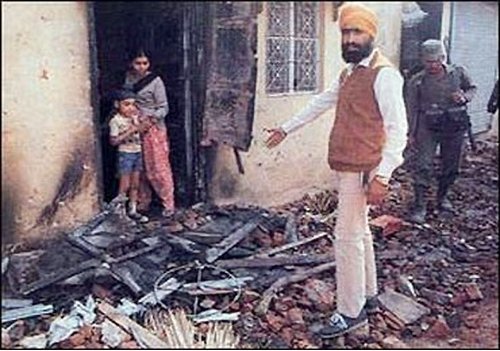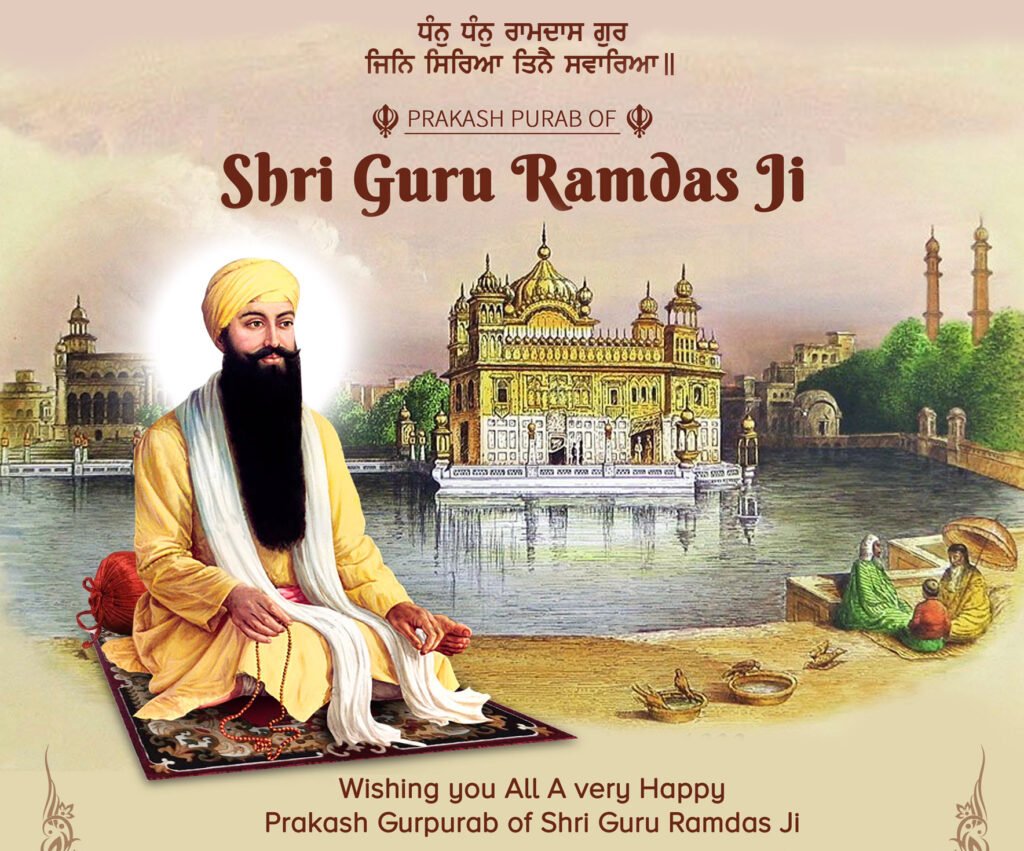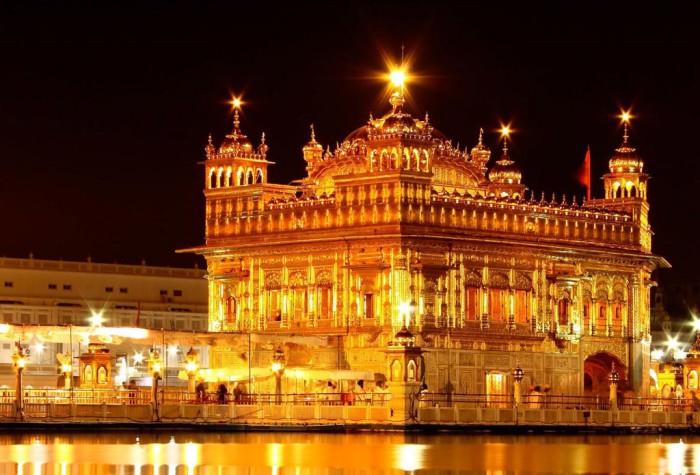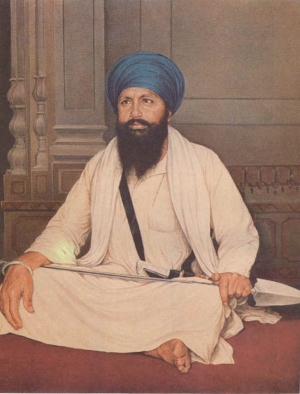The Guru Granth Sahib is a sacred scripture of the world and is the Eternal Guru of the Sikhs. Because it is a scripture suitable of a universal religion, many world class philosophers and holy men consider it a unique treasure and a noble heritage for all humankind. Because, it is the Guru of the Sikhs, its adoration or veneration is an article of faith with the Sikhs. In the year 2004, the world will celebrate the Quad-Centennial of the Granth’s First Compilation. In 2008, the Sikhs will celebrate the Tercentennial of the Canonization of the Granth as the Sri Guru Granth Sahib.
The sacred verses of Sri Guru Granth Sahib are called Gurbani, which means the Guru’s word or the song messages enshrined in Sri Guru Granth Sahib. In Sikhism, the Guru is the ‘Wisdom of the Word’ and not a human or a book. God revealed the Word through the holy men and women from time to time, and the most recent revelations were entered in the text of Sri Guru Granth Sahib. To the Sikhs, any scripture not included in the Guru Granth is unacceptable as the Guru’s word or authority behind their theology, and it is not allowed to be recited, sung, or discussed in Sikh congregations with only exception for the compositions of Guru Gobind Singh, Bhai Gurdas and Bhai Nand Lal. These were considered to elucidate the Guru Granth verses. Those who explain the scripture or teach the doctrines contained in the scripture are respected as teachers, granthi, missionaries, saints or enlightened souls in the Sikh religion.
The Sikhs regard Sri Guru Granth Sahib as a complete, inviolable and final embodiment of the message for them. There is to be no word beyond the Word. And that’s how their last guru, Guru Gobind Singh, spoke to the congregation on October 20, 1708 shortly before his ascension.
“Those who desire to behold the Guru should obey the Granth Sahib. Its contents are the visible body of the Guru.”
Sri Guru Granth Sahib contains hymns of 36 composers written in twenty-two languages employing a phonetically perfected Gurmukhi script on 1430 pages in 511,874 words, 1,720,345 characters, and 28,534 lines. It has been preserved in its original format since its last completion by Guru Gobind Singh in 1705.Image Loading
It is well known that religious institutions protect themselves from erosion by enshrining their tenets and doctrines in some tangible form. The best and the most modern form of preserving the doctrinal purity today is the use of printed media and electronic storage. At the time of the Granth’s compilation, the Sikh gurus could make use of only handwritten books, and they used this medium wisely. If available, all of the founders and the followers of great religions would have liked to compile one volume of their scriptures, as the Sikh gurus did, to preserve their scriptures for posterity.
Guru Granth was composed in poetry perhaps to both prevent alterations or adulterations, and to reach out to human heart. According to some writers, “its power is the power of the puissant and winged word, and no exegesis or commentary or translation can ever convey the full beauty of its thought and poetry.” Further, poetry can be left to the culture and the times that follow to best interpret the message.
Thus the Guru Granth incorporates all of the features to place it alongside the world’s greatest scriptures. Besides, this is the only scripture which in spite of its interfaith nature was dictated, edited, proof-read, and signed for authenticity by the founders of the faith in their life time. These unique features helped preserve the Sikh religion throughout the numerous onslaughts it endured over the period of five centuries. The Granth proved to be a sufficiently foolproof means for continuously providing safeguard against adulteration and extinction of the Sikh religion for centuries to come.
The fifth Sikh Guru, Arjan Dev first compiled the Guru Granth in I604 in the city of Amritsar. Guru Gobind Singh prepared the second edition, which he completed at Damdama, a town in the State of Punjab in India in 1705. Since then, his authorized version has been transcribed and printed numerous times; it always conforms to the Damdama edition in every respect. More recently the text in its original font is available electronically on many web sites for every one to have free access. In addition to the edition in original Gurmukhi script, the Guru Granth on the web is available in Hindi, Sindhi, and roman English transliterations. Whereas translations in English, French, Spanish, Punjabi, Hindi, Sindhi and German are already available, those in Thai, Urdu, Hebrew and many Indic languages are in preparation.
The Granth compiled by Guru Arjan contained the hymns of the first five Gurus along with most of the saints and holy men of medieval India and the Far East. He installed this scripture in the Sikhs’central shrine, Hari Mandar, at the City of Golden Temple in 1604. Later, this copy was taken into possession by guru’s rivals who would not wish to share it freely with the mainstream Sikhs. Guru Gobind Singh took upon himself to recreate the entire Granth. He dictated to a Sikh scholar, Bhai Mani Singh, all verses he considered revealed including the hymns written after Guru Arjan. It took him nearly five years at Anadpur Sahib and Damdama Sahib to complete this project in 1705. He founded Dandama town to immortalize this occasion.
On October 20, 1708 Guru Gobind Singh gave his final sermon that conferred permanent gurudom on the Damdama version of the Granth. He selected town of Naderh several hundred miles away from Damdama for this event. Since that day, the Granth has come to be known as Sri Guru Granth Sahib.
Sri Guru Granth Sahib contains 5894 hymns. Guru Arjan contributed the largest number of 2216 hymns. Besides the hymns of other Gurus, he also included 937 hymns of fifteen other saints and eleven poet laureates of the Guru’s court whose compositions tallied with the gospel of the Sikh faith. Here, the Hindu, the Muslim, the Brahmin, and the untouchable, all meet in the same congregation of holy souls to create a truly universal scripture for our world.
From the linguistic point of view, Sri Guru Granth Sahib is a treasury of the languages of its times that communicated well with every segment of the society. The language principally employed is the language of the saints, evolved during the medieval period. Based upon the local dialects, it was leavened with expressions from Sanskrit, Prakrit, Persian, Arabic, Bengali and Marathi etc. This language allowed for variations and still enjoyed wide currency in Southeast Asia. Its appeal is found in its directness, energy and resilience. In addition, the Guru designed a phonetically complete gurmukhi font to meet the need of inscribing the multi-linguistic scripture that is also musical.
The poetry of the Granth is in itself a subject worthy of the highest consideration. Music forms the basis of the rhythms and classification of the hymns. They follow a definite metrical system called raags. A raag in Indian classical music means a pattern of melodic notes. This form is not only used to preserve the originality of the composition, as the poetry written in this form is difficult to imitate, but more so to provide the divine experience through the medium of music and the sounds of God’s creation. The total number of ragas is 31. The gurus themselves invented some of those. Under each Raag, the hymns are arranged in different meters as Chaupadas and Ashtapadas; long poems include Chhands, Vars, and Bhagat verses.
Another outstanding feature of the Guru Granth is the rescission and beauty of its prosody. Whilst a great deal of it is cast in traditional verse forms (e.g. shlokas and paudis), and could best be understood in the context of the well-known classical raags, several hymns and songs make use of popular folklore and meters (e.g. alahanis, ghoris, chands, etc.). The inner and integral relationship between music and verse has been maintained with scholarly rectitude and concern. The complete musicalization of thought was accomplished in a scientific and scholarly manner so that it makes for the unusually vigorous yet supple discipline of the Granth’s own metrics and notations.
The Guru Granth verses are often sung in a process known as kirtan. In this process true meaning is revealed directly to the Surat (consciousness and awareness) through cosmic vibrations. The body’s energetic vibrations from our voices bond us to the spiritual light of universal intelligence. As we chant the Granth’s verses the universe speaks to us in metaphoric images. The physical body of the singer experiences the essence of each word through the lightening energy in the brain and the calming vibrations in the body, all caused by the sound currents. They keep the mind to stay focused on the Word. They heal the physical body and cleanse inner thoughts. The sound waves of the Gurmat Raags connect the mind, body, and spirit by alignment of the physical, emotional, mental, and spiritual entities. They implant in the psyche the basis for both spiritual and mental growth. To see a Sikh congregation chant the sacred hymns in unison is to see massed spiritual energy bubble before your eyes. This is how the ordinary words change into the logos and become auspicious.
Reading of Sri Guru Granth Sahib, known as Gurbani paath, is a sacred rite for every Sikh that permits a connection to the Guru for spiritual guidance. It is more than a simple ritual or a complex scholarly endeavor; intellectual deliberation is engaged to seek wisdom while faith is cultivated in the process to receive the inner light. Reading the rhythmic poetry of Guru Granth is considered by some as healing in itself. Its chant is frequently prescribed to patients for relief of their symptoms and to reduce illnesses. It seems to facilitate understanding of pain and pleasure by “mindfulness” or “being in the moment”.
In mystic literature of Guru Granth the appeal of the numinous becomes ineffable, if not inexplicable. And yet the great Sikh scripture is not a knot of metaphysical riddles and abstract theorizing. For the most part it employs the idiom of the common people, and draws its imagery and metaphors from the home, the street and the work place. The hymns of the Guru Granth show an admirable use of the current figures of speech apart from their metrical richness and sweetness. Imagery was taken from everyday life and common occurrence to simplify subtle thoughts and profound concepts. The Gurus were keen lovers of nature and as such, have written glowing descriptions of panoramic environmental beauty, changes in the times of day, and the changes of seasons to inculcate love for the One Creator. Thus they made Guru Granth poetry an extraordinary breed of divinity, mysticism, immediacy, concreteness and urgency with which it touches the human heart.
One of the greatest glories of the Guru Granth is its all-embracing character. It is a scripture completely free from bias, animus and controversy. Indeed, the uniqueness of the Granth in this respect is all the more astonishing when we think of the obscurantism, factionalism and religious fanaticism of the periods in which it was composed. They were all counterbalanced by inclusion of the songs and verses of a wide diversity of holy men, saints, savants and bards. Of course, their hymns and couplets rendered in their own language and idiom were so dovetailed as to find a complete correspondence with themes or motifs in the compositions of the Sikh Gurus.
The Guru Granth, then, is unique in that it formed the first interfaith and still universal scripture. It is indeed a magnificent compendium of the religious, mystic and metaphysical poetry written or recited between the I2th and 17th centuries in different parts of the Mid-Eastern and Far-Eastern continents. It is also at the same time a reflection of the sociological, economic and political conditions of the day. The satire on the reactionary rulers, the obscurantist clergy, the fake fakirs and the like is uncompromising and telling. In showing the path to spiritual salvation, the Guru Granth does not ignore the secular and creative life of living beings. In addition to its mysticism and spiritual depth, the poetry of the Gurus throws light on their contemporary situations. It lays bare the corruption and degradation of the society of those times and underscores the need of social reform and economic uplift. Guru Granth verses advocate a spiritual soul for their otherwise inhumane administration of the then rulers.
Obviously, the idea of Guru Arjan Dev was to celebrate the diversity in all religions and mystic experiences, and, at the same time, establish the fundamental unity of spirituality and faith through the scripture of Sri Guru Granth Sahib. In this scripture he founded an integral congress of all minds and souls operating on the same spiritual vibration. He elevated the songs of the saints, the Sufis and the bards to the elevation of the logos to salute the power of the Word whatever form it might take to reveal the glory of the One Reality.
The Sikhs in particular and the religious world in general must be congratulated to be the recipients of the unique scripture of Sri Guru Granth Sahib. We, the Sikhs, must be humble and grateful to be chosen by Guru Gobind Singh who assigned us the task of the keepers of the light of Sri Guru Granth Sahib on this Day of October 20, 1708.



















